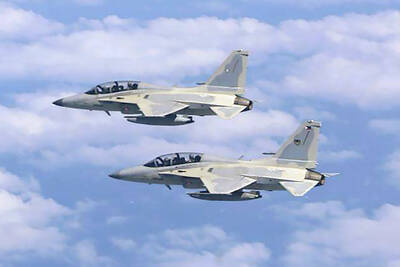With the constant churn of freighter propellers, the percussive thump of oil and gas exploration and the underwater din of military testing, ocean noise levels have become unbearable for some sea mammals.
Contrary to the image of a distant and silent world under the sea, underwater sound intensity has on average soared 20 decibels over the past 50 years, with devastating consequences for wildlife.
“Sound is what cetaceans [large aquatic mammals like whales and dolphins] communicate with. This is how they perceive their environment. For them, hearing is as important as vision is for us,” said Mark Simmonds, the international director of science at the Whale and Dolphin Conservation Society (WDCS).
“If there is too much noise, they probably can’t communicate that well,” he said late last month on the sidelines of an international conference on migratory species in Bergen, on Norway’s southwestern coast.
A harmful effect of this acoustic “fog” is that it impairs the ability of cetaceans, which in good conditions can communicate over a distance of dozens of kilometers, to orient themselves, find food and reproduce.
Basic small boat traffic traveling at slow speeds through shallow waters can be enough to cut the reach of sounds from a bottlenose dolphin, for instance, by 26 percent, and in the case of pilot whales by 58 percent, according to a recent study.
Nicolas Entrup, who works with the non-governmental organizations Ocean Care and the Natural Resources Defense Council, said the ocean is in the process of becoming for sea mammals what night clubs are for humans.
“You might cope with it for a while, but you can’t live there,” he said.
“Imagine a situation where you can’t communicate with your family, where you have to scream constantly,” he said.
Oceans are vast and animals that are bothered by rising noise levels can of course move on, but it can be challenging to find and adapt to a whole new habitat.
The problem is especially dire in the Arctic, where, as the polar ice cap melts, humans are leaving an ever bigger sound footprint as they stake out new shipping routes and look for oil and gas.
“Narwals, for example, have a narrowly defined habitat,” Simmonds said. “They are very adapted to that cold environment. If it gets too noisy, where will they go?”
The same problem applies to the highly sound-sensitive beluga, or white whale, that migrates to Canada’s northern shores.
These mammals, which are capable of detecting ships 30km away, will struggle to maintain their migration route through the narrow straits circling Baffin Island as shipping in the area risks increasing sharply to accommodate a new large-scale mining project.
“We simply don’t know how certain species will adapt, or even if they will adapt at all,” Simmonds said.
In some cases, human-produced commotion is fatal.
The use of anti-submarine sonars is, for instance, suspected of causing the mass-beaching of whales: In 2002, about 15 beaked whales perished in the Canary Islands after a NATO exercise.
“Since we’re talking about military matters, there is no transparent information available and we know very little of the real scope of the problem,” Entrup said.
Other threats include seismic exploration for oil and gas, which involves the use of air canons to induce tremors in the seabed aimed at detecting the potential riches hidden below.
One such project carried out a few years ago off the northeastern shores of the US literally silenced the fin whales — an endangered species — in an area about the size of Alaska, blocking their ability to communicate for the duration of the operation.
Danger can also emerge from more “environmentally friendly” projects, like the building of vast offshore wind farms consisting of ever larger turbines.
A common technique consists of penetrating the seabed with a hydraulic hammer to plant a monopod anchoring the modern-day windmills to the ocean floor.
This pile-driving can emit noise levels up to 250 decibels, which is a deadly dose for nearby marine mammals, though experts say it’s easy to diminish the threat by creating a curtain of air bubbles surrounding the drill site.
However, on top of pile-driving, ship traffic linked to maintenance, cable-laying and the expansion of port infrastructure are also shrinking sea mammals’ habitats.
“The picture is bleak, but now we have the knowledge and the methodology to remedy some of the problems,” said Michel Andre, a French researcher at the Laboratory of Applied Bioacoustics at Barcelona University who is coordinating a project to map seabed sound levels.
“It is, for instance, fairly easy to reduce the sounds made by boats,” he said, adding: “Just look at the military, they already know how to do that.”
Europe has been a pioneer in this area, according to Andre, pointing to the European Commission’s financing of Ships-Oriented Innovative Solutions to Reduce Noise and Vibrations.
The project, which has 14 partner nations, aims to create an “acoustic green label” for ships.
The EU is also working on a directive to reduce noise levels in its waters and hopes to inspire others to follow.

OPTIMISTIC: A Philippine Air Force spokeswoman said the military believed the crew were safe and were hopeful that they and the jet would be recovered A Philippine Air Force FA-50 jet and its two-person crew are missing after flying in support of ground forces fighting communist rebels in the southern Mindanao region, a military official said yesterday. Philippine Air Force spokeswoman Colonel Consuelo Castillo said the jet was flying “over land” on the way to its target area when it went missing during a “tactical night operation in support of our ground troops.” While she declined to provide mission specifics, Philippine Army spokesman Colonel Louie Dema-ala confirmed that the missing FA-50 was part of a squadron sent “to provide air support” to troops fighting communist rebels in

ECONOMIC DISTORTION? The US commerce secretary’s remarks echoed Elon Musk’s arguments that spending by the government does not create value for the economy US Secretary of Commerce Howard Lutnick on Sunday said that government spending could be separated from GDP reports, in response to questions about whether the spending cuts pushed by Elon Musk’s Department of Government Efficiency could possibly cause an economic downturn. “You know that governments historically have messed with GDP,” Lutnick said on Fox News Channel’s Sunday Morning Futures. “They count government spending as part of GDP. So I’m going to separate those two and make it transparent.” Doing so could potentially complicate or distort a fundamental measure of the US economy’s health. Government spending is traditionally included in the GDP because

Two daughters of an Argentine mountaineer who died on an icy peak 40 years ago have retrieved his backpack from the spot — finding camera film inside that allowed them a glimpse of some of his final experiences. Guillermo Vieiro was 44 when he died in 1985 — as did his climbing partner — while descending Argentina’s Tupungato lava dome, one of the highest peaks in the Americas. Last year, his backpack was spotted on a slope by mountaineer Gabriela Cavallaro, who examined it and contacted Vieiro’s daughters Guadalupe, 40, and Azul, 44. Last month, the three set out with four other guides

Sri Lanka’s fragile economic recovery could be hampered by threatened trade union strikes over reduced benefits for government employees in this year’s budget, the IMF said yesterday. Sri Lankan President Anura Kumara Dissanayake’s maiden budget raised public sector salaries, but also made deep cuts to longstanding perks in a continuing effort to repair the island nation’s tattered finances. Sri Lanka’s main doctors’ union is considering a strike from today to protest against cuts to their allowances, while teachers are also considering stoppages. IMF senior mission chief for Sri Lanka Peter Breuer said the budget was the “last big push” for the country’s austerity